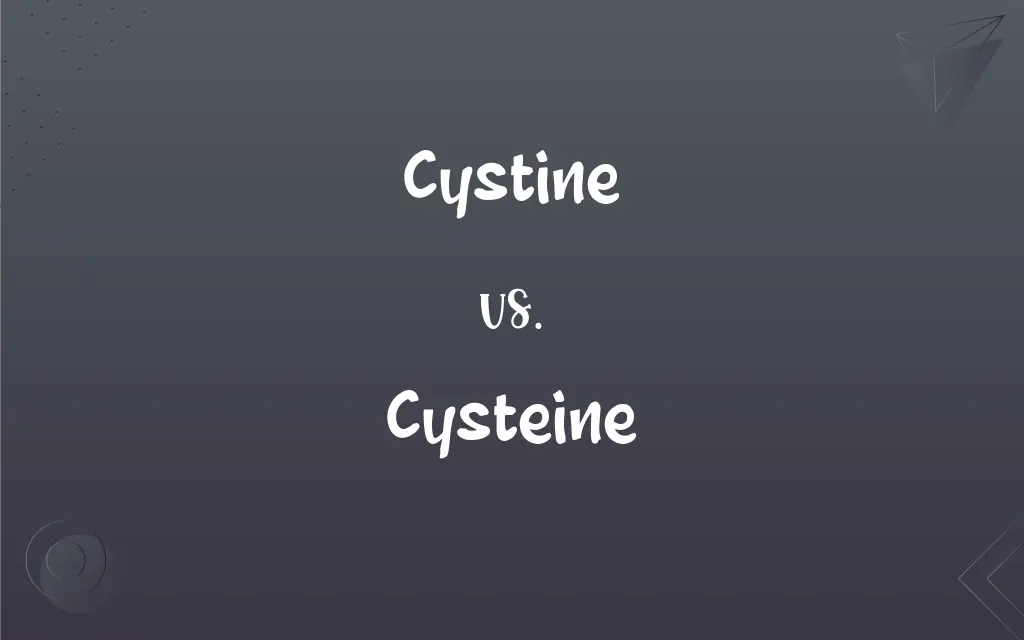Cystine vs. Cysteine: What's the Difference?
Edited by Aimie Carlson || By Harlon Moss || Updated on October 9, 2023
Cysteine is a sulfur-containing amino acid vital for protein synthesis, while cystine consists of two cysteine molecules connected by a disulfide bond, often serving to structurally stabilize proteins.

Key Differences
Cysteine stands recognized as a semi-essential amino acid, vital in various physiological processes and widely acknowledged for its role in protein synthesis. Conversely, cystine, which may initially appear synonymous, distinguishes itself through its specific structural configuration, being comprised of two cysteine molecules linked by a disulfide bond, which is pivotal for maintaining protein structures.
When probing the biochemical significance, cysteine emerges as a crucial player in various enzymatic reactions and metabolic pathways due to its reactive thiol (-SH) group. Cystine, while inherently related due to its cysteine foundations, reveals its importance predominantly through providing structural rigidity to proteins and enzymes by forming disulfide bridges, thereby ensuring conformational stability and functionality.
In the context of nutritional and physiological roles, cysteine can be synthesized within the body and is thus categorized as a semi-essential amino acid. Cystine, being a derivative of cysteine, holds esteem particularly in conditions of oxidative stress, wherein it can be reduced back to two cysteine molecules, thereby supporting the continual synthesis of glutathione, a crucial antioxidant.
It is essential to recognize that cysteine is a fundamental building block, appearing ubiquitously throughout biological systems, contributing notably to the synthesis of glutathione and facilitating detoxification processes. In contrast, cystine, while not directly engaged in synthesis processes like cysteine, plays an indirect but crucial role, given that its presence ensures the structural integrity of various proteins, thereby underpinning numerous biological systems and processes.
Comparison Chart
Structural Composition
Single amino acid.
Two cysteine molecules connected.
ADVERTISEMENT
Role in Proteins
Participates in protein synthesis.
Provides structural stability to proteins.
Oxidation State
Reduced form.
Oxidized form.
Functional Group
Contains a thiol (-SH) group.
Contains a disulfide bond.
Involvement in Antioxidant Synthesis
Directly involved in synthesizing glutathione.
Converted to cysteine to support glutathione synthesis.
Cystine and Cysteine Definitions
Cystine
Cystine, while not directly involved in enzymatic reactions, is crucial in ensuring the structural conformation of many enzymes.
Cystine’s presence in the enzyme was deemed crucial for maintaining its active conformation.
ADVERTISEMENT
Cysteine
Cysteine is recognized for its active thiol group, capable of undergoing oxidation and reduction.
The reactive thiol group in cysteine enables it to participate in redox reactions within cells.
Cystine
Cystine can be converted back into two cysteine molecules under reductive conditions.
In certain metabolic pathways, cystine is reduced back to cysteine, playing a key role in maintaining antioxidant reserves.
Cysteine
Cysteine is involved in the catalytic activity of various enzymes due to its reactivity.
Cysteine residues often form part of the active site in enzymes, facilitating substrate binding and transformation.
Cystine
Cystine is a non-essential amino acid formed by linking two cysteine molecules via a disulfide bond.
Cystine plays a pivotal role in fortifying the structural integrity of numerous proteins.
Cysteine
Cysteine is a semi-essential amino acid renowned for its sulfur-containing side chain.
Cysteine is crucial for synthesizing proteins and facilitating various metabolic reactions.
Cystine
Cystine materializes as a dimeric amino acid, essentially being an oxidized form of cysteine.
The researcher explored how cystine contributes to the cellular redox balance.
Cysteine
Cysteine is pivotal in the synthesis of glutathione, a potent intracellular antioxidant.
The biosynthesis of glutathione relies significantly on the availability of cysteine.
Cystine
Cystine is often recognized for its role in providing structural stability to proteins through the formation of disulfide bridges.
The structural biologist studied how cystine mediated protein folding via disulfide linkage.
Cysteine
Cysteine can form disulfide bonds, influencing the three-dimensional structure of proteins.
The disulfide bonds formed by cysteine residues contribute to the stability of protein structures.
Cystine
A white crystalline amino acid, C6H12N2O4S2, that is formed from the disulfide linkage of two cysteines during the folding of many proteins, especially keratin, and stabilizes the tertiary structure of the protein.
Cysteine
An amino acid, C3H7O2NS, derived from cystine and found in most proteins.
Cystine
(chemistry) A nonessential amino acid formed by the oxidation of cysteine; it contains two cysteine residues linked by a disulfide bond.
Cysteine
(amino acid) A sulphur-containing nonessential amino acid C3H7NO2S found in most animal proteins; it readily oxidizes to cystine.
Cystine
A white crystalline substance, C3H7NSO2, containing sulphur, occuring as a constituent of certain rare urinary calculi, and occasionally found as a sediment in urine.
Cysteine
An amino acid containing sulfur that is found in most proteins; oxidizes on exposure to air to form cystine
Cystine
A crystalline amino acid found in proteins (especially keratin); discovered in bladder stones
FAQs
What is cysteine?
Cysteine is a semi-essential, sulfur-containing amino acid.
How does cystine contribute to protein structure?
Cystine stabilizes protein structures through forming disulfide bridges between peptide chains.
Are cysteine and cystine essential amino acids?
Cysteine is semi-essential, while cystine, as a dimer of cysteine, is considered non-essential.
What is the role of cysteine in proteins?
Cysteine helps in protein synthesis and can influence protein structure via disulfide bond formation.
What foods are rich in cysteine?
Foods like poultry, yogurt, egg, garlic, and onions are rich in cysteine.
How are cystine and cysteine implicated in metabolic processes?
They are involved in metabolic processes as building blocks for proteins and mediators of redox reactions.
Why does cystine often get mentioned in nutritional supplements?
Cystine is mentioned due to its role in protein stabilization and as a component of some antioxidant supplements.
Can a deficiency of cysteine impact health?
Yes, a deficiency might impact protein synthesis, antioxidant defense, and overall metabolic health.
How is cystine formed?
Cystine is formed by linking two cysteine molecules via a disulfide bond.
How is cysteine synthesized in the body?
Cysteine can be synthesized from the amino acid methionine and serine in the liver.
What is the clinical significance of cystine?
Excess cystine can lead to cystinuria, a condition where cystine crystals form stones in the kidney.
How does cysteine function in enzymatic reactions?
Cysteine’s thiol group can interact with substrates and facilitate enzymatic transformations.
Can cysteine act as an antioxidant?
Yes, cysteine is a precursor to glutathione, a powerful antioxidant.
What is the major role of cystine in cells?
Cystine contributes to maintaining protein structure and can be converted to cysteine as needed.
How are cystine and cysteine related to aging?
They both play roles in antioxidative processes, impacting cellular aging and oxidative stress.
Can cystine and cysteine assist in detoxification processes?
Yes, they're involved in the synthesis of glutathione, which plays a role in detoxifying cells.
What are the cosmetic applications of cysteine?
Cysteine is used in hair straightening treatments and some skincare products for its reductive properties.
Why is cystine important for cellular health?
Cystine supports cellular health by stabilizing protein structures and participating in antioxidant defense.
Are cystine and cysteine safe as supplements?
Generally, yes, but excessive intake, especially without medical advice, might have adverse effects.
How does cysteine impact hair structure?
Disulfide bonds between cysteine residues in keratin provide strength and resilience to hair.
About Author
Written by
Harlon MossHarlon is a seasoned quality moderator and accomplished content writer for Difference Wiki. An alumnus of the prestigious University of California, he earned his degree in Computer Science. Leveraging his academic background, Harlon brings a meticulous and informed perspective to his work, ensuring content accuracy and excellence.
Edited by
Aimie CarlsonAimie Carlson, holding a master's degree in English literature, is a fervent English language enthusiast. She lends her writing talents to Difference Wiki, a prominent website that specializes in comparisons, offering readers insightful analyses that both captivate and inform.































































